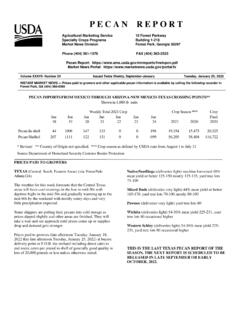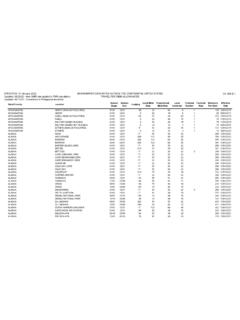Transcription of January 2022 HIT Monitoring Report - cms.gov
1 HIT Monitoring Report January 2022. Executive Summary Under Fee-for-service (FFS) Medicare, home infusion therapy (HIT) involves the intravenous or subcutaneous administration of drugs or biologicals to an individual at home. The components needed to perform home infusion include the drug (for example, antivirals, immune globulin), equipment (for example, a pump), and supplies (for example, tubing and catheters). Likewise, nursing services are necessary to train and educate the patient and caregivers on the safe administration of infusion drugs in the home. Visiting nurses often play a large role in home infusion. Nurses typically train the patient or caregiver to self-administer the drug, educate on side effects and goals of therapy, and visit periodically to assess the infusion site and provide dressing changes.
2 The home infusion process typically requires coordination among multiple entities, including patients, physicians, hospital discharge planners, health plans, home infusion pharmacies, and, if applicable, home health agencies. This Report summarizes utilization for the HIT service visits (Exhibits 1 through 4), characteristics of HIT. recipients (Exhibits 5 through 7), and characteristics of DME/HIT supplier organizations (Exhibits 8. through 10). Data are presented through the end of the first quarter (Q1) of 2021. Important aspects of this version of the Report are (1) utilization during the COVID-19 public health emergency (PHE), and (2) the transition from the temporary transitional payment (TTP) period to the permanent benefit, which began on January 1, 2021.
3 There are two major changes between the TTP and the permanent benefit. First, under the TTP, only DME suppliers can provide HIT service visits. Under the permanent benefit, any qualified HIT supplier who is accredited and enrolled in Medicare can provide HIT service visits. Second, the list of HIT-eligible drugs changed slightly with three low-utilization drugs being removed (Morphine Sulfate, Preservative Free, Ziconotide, and Floxuridine) and one subcutaneous immune globulin drug (XEMBIFY) being added. From Q1 2019 to Q1 2021, the quarterly average of HIT service visits remains low at about 6,000 visits. Although the two highest quarters over that time period occurred during the PHE (Q1 and Q2 2020), the rate of utilization growth appears to have slowed during the PHE.
4 The number of HIT service visits has since decreased to 5,382 visits during the first quarter of the permanent benefit (Q1 2021). For the past twelve months, utilization has been concentrated in the Mid-Atlantic and Florida, which is partly reflected by the concentration of Medicare fee-for-service (FFS) enrollment in those locations. Similarly, HIT service visit recipients tend to be white and under 75 years of age. The HIT market is very concentrated with 5 of the 80 DME/HIT suppliers providing almost half of the HIT. service visits in the past twelve months. The quarterly average of DME/HIT supplier organizations declined from 55 during 2019 (the first year of the TTP period), to 53 (the second year of the TTP. period), to 40 in Q1 2021 (the first quarter of the permanent benefit).
5 Overall Methodology Data for analyses come from the CMS Chronic Conditions Warehouse Virtual Research Data Center (CCW VRDC), where 100% of HIT related Medicare Part B claims are extracted quarterly beginning with quarter 1 (Q1) of 2019. For this Report we examine the nine quarters of data that exist from Q1 2019. through Q1 2021. Each quarter of data is extracted seven months after the quarter's end to account for claims processing timelines. 1 These data are used to track HIT utilization among Medicare fee-for- service (FFS) beneficiaries with Part B coverage during the temporary transitional payment (TTP) period, spanning January 1, 2019 to December 31, 2020, and the permanent benefit, which began January 1, 2021. We identify HIT drug fills by identifying DME claim line-items that include the HCPCS code for one of the 37 drugs covered by the TTP for claims in calendar years 2019-2020, 2 or one of the 34 drugs covered by the permanent benefit for claims on or after January 1, 2021.
6 3 Any beneficiary with a HIT drug fill is considered a HIT drug recipient . All HIT drug recipients are potentially eligible to receive HIT. professional service visits through the TTP and the permanent HIT benefit. Under both the TTP and the permanent HIT benefit, CMS pays HIT suppliers for professional services furnished for each infusion drug administration calendar day. 4 Medicare covers the professional services for three payment categories of HIT drugs: Category 1 for certain intravenous infusion drugs for therapy, prophylaxis, or diagnosis, including antifungals and antivirals; inotropic and pulmonary hypertension drugs; pain management drugs; and chelation drugs, Category 2 for subcutaneous infusions for therapy or prophylaxis, including certain subcutaneous immunotherapy infusions, and Category 3 for chemotherapy drugs or other highly complex infusion drugs or biologicals Because utilization patterns and beneficiary characteristics can vary by drug category, many of the tables and figures below present findings by drug category.
7 We identify HIT service visits when a HIT claim line-item includes one of the following payment category-specific HCPCS codes (G-codes) in calendar years 2019 and 2020: G0068 for HIT service visits related to Category 1 drugs, G0069 for HIT service visits related to Category 2 drugs, and G0070 for HIT. service visits related to Category 3 drugs. 5,6 Beginning January 1, 2021, three additional HIT service visit 1. Providers have up to a year from service date to submit claims ( Guidance/Guidance/Manuals/ ). Table 3 of the CCW White Paper: Medicare Claims Maturity indicates that over 95 percent of claims are final after six months ( ). 2. 3. 4. For more details on Medicare reimbursement of HIT service visits, consult Pub 100-04 Medicare Claims Processing Transmittal 10547 ( ).
8 5. For the TTP, HIT claims are located on the durable medical equipment (DME) Medicare Part B claims. For the permanent benefit, the HIT claims are located on the carrier Medicare Part B claims. 6. MLN/MLNM attersArticles/ G-codes were added to differentiate between initial and subsequent visits. In 2021, the G-codes used during the TTP period are used for subsequent visits, whereas the three additional G-codes (G0088, G0089, and G0090, ordered by payment category) are used for initial visits. 7 Any beneficiary with a HIT. service visit is considered a HIT service visit recipient. Additional information on the HIT drug and service visit codes can be found in Appendix A. 7. Exhibit 1. Number of HIT service visits by drug category (Q1 2019 Q1. 2021).
9 Source: Analyses of Medicare FFS Part B DME claims (Accessed from CCW VRDC on October 29, 2021). Exhibit 2. Breakdown of HIT service visits by initial/subsequent visit and by drug category under the Temporary Transitional Payment (CY 2019 &. 2020) and Permanent HIT Benefit (Q1 2021). Type of HIT Category 1 Category 2 Category 3 Total Service Visit N % N % N % N %. CY 2019 & 2020. Initial 991 1,341 2,040 4,372 Subsequent 12,671 7,250 20,696 40,617 Total 13,662 8,591 22,736 44,989 2021 (Q1). Initial 81 31 82 194 Subsequent 2,879 532 1,777 5,188 Total 2,960 563 1,859 5,382 Category 1: Intravenous anti-infective, pain management, chelation, pulmonary hypertension, and inotropic drugs. Category 2: Subcutaneous infusions including immunotherapy drugs. Category 3: Highly complex intravenous infusions including chemotherapy drugs.
10 Source: Analyses of Medicare FFS Part B DME claims (Accessed from CCW VRDC on October 29, 2021). Exhibit 3. Utilization of HIT service visits by HIT drug category and linked drug, past twelve months (ending 3/31/2021). Frequency of Drug HIT Service Share of Drug Share of All HIT. Category Linked Drug Visits Category Service Visits Category 1 Milrinone lactate (J2260) 5,184 Dobutamine HCl (J1250) 621 Treprostinil (J3285) 218 Other 2,737 Category 1 Total 8,760 Category 2 Hizentra (J1559 JB) 1,905 Hyqvia (J1575 JB) 906 Cuvitru (J1555 JB) 649 Other 1,129 Category 2 Total 4,589 Category 3 Fluorouracil (J9190) 8,659 Blinatumomab (J9039) 193 Doxorubicin HCl (J9000) 26 Other 1,379 Category 3 Total 10,257 Category 1: Intravenous anti-infective, pain management, chelation, pulmonary hypertension, and inotropic drugs.
















